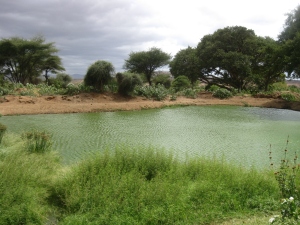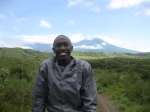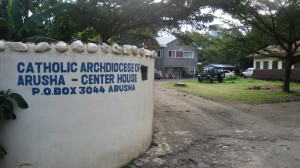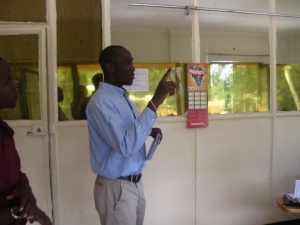Hello again! I hope everyone is doing well since my last post. I apologize about the long gap between posts. I’m still not 100% sure why, but my computer froze up a few weeks back and has been out of commission since. Luckily, one of our translators (Michael Paul) is a computer genius and helped me get things up and running. Pending nothing else goes wrong, I should be able to update the blog much more often. Yay!
That being said, thank you for all the great feedback and support from my last post! It was great hearing from everyone that left comments. I definitely miss everyone! A lot has happened since my last blog post. Below is an update from ~three weeks ago, the week of June 6th (pre computer crash). I am currently still in Namanga and teaching secondary school students (8th & 9th graders) for a two week day camp. I will try and type up my journal entries, plus pictures, and post them this weekend.
Week of June 6th
 ~Three weeks ago myself and a few other volunteers shipped off to Namanga, Tanzania, which is situated just on the border of Kenya and Tanzania. If you remember from my previous entry of my shuttle ride from Nairobi to Arusha, it’s the small town I stopped at to pass through immigration before entering Tanzania. The town has just over 12,000 people (wouldn’t guess it from the picture) and is largely dominated by the Maasai tribe. They would be the primary recipients of our training in nutrition and food drying techniques for the week.
~Three weeks ago myself and a few other volunteers shipped off to Namanga, Tanzania, which is situated just on the border of Kenya and Tanzania. If you remember from my previous entry of my shuttle ride from Nairobi to Arusha, it’s the small town I stopped at to pass through immigration before entering Tanzania. The town has just over 12,000 people (wouldn’t guess it from the picture) and is largely dominated by the Maasai tribe. They would be the primary recipients of our training in nutrition and food drying techniques for the week.
Maasai are traditionally nomadic herders of cows, so their diet mainly consists of beef, ugali (a corn meal based food) and milk. Culturally, Massai men think very poorly of eating anything else but meat, so vegetables and fruits are very often neglected from the diet and left for the women (I personally didn’t see the problem…kidding). Unfortunately, due to the inconsistent rains and consequent droughts in Tanzania and Kenya, pastures for the cows to graze have been few and far between. Many cows have died, and as a result, many Maasai have suffered malnutrion and hunger from the lack of food. Sadly, when all you know is herding it’s difficult to survive such difficult times.
This is where we come in. Our efforts a few weeks back were three fold. First, we continued the ongoing efforts of explaining to the Massai women why other food groups are not only acceptable but essential to the diet. Since the women do all the cooking, by encouraging them to diversify the diet and including alternatives to meat – if they are able – malnutrition can hopefully be avoided in the children, women, and men that are willing to change their ways. Given the recent droughts, it’s been much easier to make this argument than in the past.
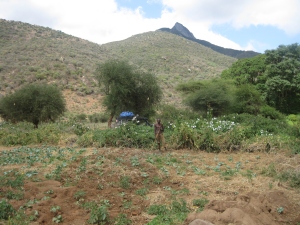
Second, we continued trainings on sustainable agriculture and conducted checkups on previously planted crops. Seeing Maasai men farming was definitely one of the highlights of the week. Traditionally, Maasai men eat breath and sleep herding. Anything else simply has no value in their eyes. Consequently, getting them to do anything agricultural is like trying to mix oil and water. It just doesn’t work… However, given the circumstances and the lack of food, GSC has been able to teach small groups of Maasai in the Namanga area how to grow small gardens of vegetables using Bio-intensive Agriculture (BIA) techniques. Through methods of double digging and no till farming, GSC has been able to teach the Maasai how to farm and maximize crop yields in fairly harsh conditions –as you may be able to tell from the pictures. They have also helped them develop systems of water collection and irrigation for their crops. It really is quite amazing what they have been able to do in such a short amount of time.
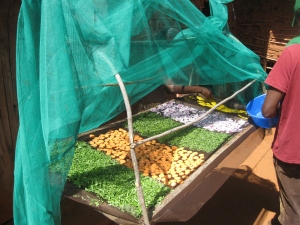 Third, for the periods where rain is plentiful and crops grow in abundance, we taught a small group of Maasai women how to build and use food driers. By capturing the natural heat from the sun, the driers are able to dry vegetables and some fruits, which can in turn be stored for up to 6 months to a year. This enables those that are willing to adopt new ways to have an extra food supply during periods of drought and food shortages, like now. Between all the trainings that we offered through the week, I gave the nutrition training and assisted in constructing food driers.
Third, for the periods where rain is plentiful and crops grow in abundance, we taught a small group of Maasai women how to build and use food driers. By capturing the natural heat from the sun, the driers are able to dry vegetables and some fruits, which can in turn be stored for up to 6 months to a year. This enables those that are willing to adopt new ways to have an extra food supply during periods of drought and food shortages, like now. Between all the trainings that we offered through the week, I gave the nutrition training and assisted in constructing food driers.
Teaching out in the villages was definitely a completely different experience than the previous week in the city. For one, most of the Maasai only speak Maasai, so we ended up needing a translator for both English and Kiswahili. Usually when I said stuff everyone sort of had a blank stare on their face, but there seemed to be a lot of nodding and mumbling after the translator spoke. That was my cue that we were all on the same page before moving on.
I have to admit, talking to the Maasai about nutrition was really… awkward. For many of the participants, this wasn’t the first time they had received the nutrition lesson. From their feedback and responses I think they got the general idea of why it’s important to not only eat meat, ugali and drink milk. However, there wasn’t very much around to diversity their diet even if they wanted to. I felt guilty teaching people something they wouldn’t be able to completely do. It’s definitely situations like this the saying “ignorance is bliss” was created.
In my guilt I ended up tailoring the lesson to focus more on making sure everyone got enough to eat each day to support all their physical labor, as opposed to emphasizing hitting all the recommended food groups. I also tried to help them identify other reasons people don’t get enough food. Though food shortages and lack of money are major obstacles, I didn’t want to neglect other road blocks that can be equally as obstructive to getting enough to eat, such as being too pre-occupied to stop and eat (I’m definitely guilty of this) or holding irrational beliefs about what is and isn’t acceptable (being picky…as Maasai tend to be). I’m still not sure if I was too presumptuous in assuming the Maasai aren’t quite able to provide fully balanced diets in their circumstances. My changes felt like the right thing to do though, and I made sure to be as respectful as possible. I learned a lot from the experience, and hopefully I will be more comfortable in similar situations in the future.
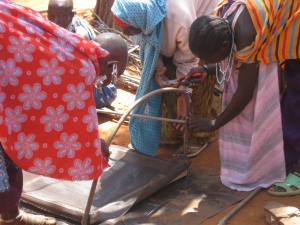 On a lighter note, another major difference from the previous week was the amount of physical work we had to do. I hate to admit it, but after 5 years of pharmacy school I am now definitely a city boy. I could talk about nutrition all day, but when it came to sawing the wood for the food driers I didn’t last five min. It was definitely a humbling experience. I was a bit worried about the women being able to handle the work, but they were more than willing to have a go at it when it was their turn. They were like a swarm of worker bees until they got it done. Considering many of them traveled on foot from quite a distance away, not to mention had to wake up early to fetch water before coming, I was very impressed by their tenacity.
On a lighter note, another major difference from the previous week was the amount of physical work we had to do. I hate to admit it, but after 5 years of pharmacy school I am now definitely a city boy. I could talk about nutrition all day, but when it came to sawing the wood for the food driers I didn’t last five min. It was definitely a humbling experience. I was a bit worried about the women being able to handle the work, but they were more than willing to have a go at it when it was their turn. They were like a swarm of worker bees until they got it done. Considering many of them traveled on foot from quite a distance away, not to mention had to wake up early to fetch water before coming, I was very impressed by their tenacity.
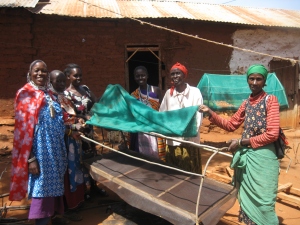
Overall, we had our ups and downs through the week, but by the end I grew very fond of the group we trained. For the first few days I found it difficult not to feel bad for the Maasai people in this region and their current circumstances. However, the more time I spent with them through the week, I witnessed just how much spirit and pride they had. With a little assistance from groups like us and a willingness to try new things, I have no doubt the Maasai people will pull through such difficult times.


